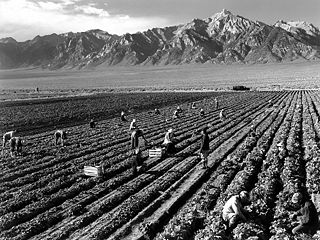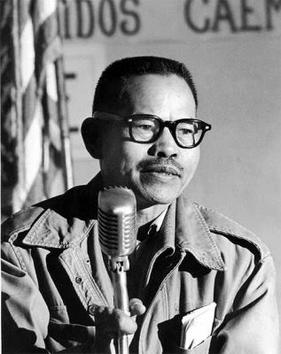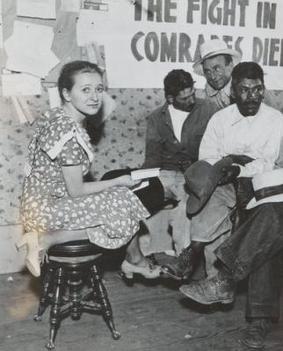Related Research Articles

The United Farm Workers of America, or more commonly just United Farm Workers (UFW), is a labor union for farmworkers in the United States. It originated from the merger of two workers' rights organizations, the Agricultural Workers Organizing Committee (AWOC) led by organizer Larry Itliong, and the National Farm Workers Association (NFWA) led by César Chávez and Dolores Huerta. They became allied and transformed from workers' rights organizations into a union as a result of a series of strikes in 1965, when the mostly Filipino farmworkers of the AWOC in Delano, California, initiated a grape strike, and the NFWA went on strike in support. As a result of the commonality in goals and methods, the NFWA and the AWOC formed the United Farm Workers Organizing Committee on August 22, 1966. This organization was accepted into the AFL–CIO in 1972 and changed its name to the United Farm Workers Union.
The Oxnard strike of 1903 was a labor rights dispute in the southern California coastal city of Oxnard between local landowners and the majority Japanese and Mexican labor force.

The Farm Labor Organizing Committee (FLOC) is a labor union representing migrant farm workers in the Midwestern United States and North Carolina.
Baldemar Velásquez is an American labor union activist. He co-founded and is president of the Farm Labor Organizing Committee, AFL-CIO. He was named a MacArthur Fellow in 1989, and awarded the Order of the Aztec Eagle in 1994, the highest honor Mexico can bestow on a non-citizen.

Philip Villamin Vera Cruz was a Filipino American labor leader, farmworker, and leader in the Asian American movement. He helped found the Agricultural Workers Organizing Committee (AWOC), which later merged with the National Farm Workers Association (NFWA) to become the United Farm Workers (UFW). As the union's long-time second vice president, he worked to improve the working conditions of migrant workers.

The Delano grape strike was a labor strike organized by the Agricultural Workers Organizing Committee (AWOC), a predominantly Filipino and AFL-CIO-sponsored labor organization, against table grape growers in Delano, California to fight against the exploitation of farm workers. The strike began on September 8, 1965, and one week later, the predominantly Mexican National Farmworkers Association (NFWA) joined the cause. In August 1966, the AWOC and the NFWA merged to create the United Farm Workers (UFW) Organizing Committee.
The United Cannery, Agricultural, Packing, and Allied Workers of America (UCAPAWA) was a labor union formed in 1937 and incorporated large numbers of Mexican, black, Asian, and Anglo food processing workers under its banner. The founders envisioned a national decentralized labor organization with power flowing from the bottom up. Although it was short-lived, the UCAPAWA influenced the lives of many workers and had a major impact for both women and minority workers in the union.

A farmworker, farmhand or agricultural worker is someone employed for labor in agriculture. In labor law, the term "farmworker" is sometimes used more narrowly, applying only to a hired worker involved in agricultural production, including harvesting, but not to a worker in other on-farm jobs, such as picking fruit.
The Hardin County onion pickers strike was a strike by agricultural workers in Hardin County, Ohio, in 1934. Led by the Agricultural Workers Union, Local 19724, the strike began on June 20, two days after the trade union formed. After the kidnapping and beating of the union's leader and the intervention of the Ohio National Guard on behalf of the growers, the strike ended in October with a partial victory for the union. Some growers met the union's demand for a 35-cents-an-hour minimum wage, but the majority did not.

Modesto "Larry" Dulay Itliong, also known as "Seven Fingers", was a Filipino-American labor organizer. He organized West Coast agricultural workers starting in the 1930s, and rose to national prominence in 1965, when he, Philip Vera Cruz, Benjamin Gines and Pete Velasco, walked off the farms of area table-grape growers, demanding wages equal to the federal minimum wage, that became known as the Delano grape strike. He has been described as "one of the fathers of the West Coast labor movement." He is regarded as a key figure of the Asian American movement.
The Stockton cannery strike of 1937, also known as the spinach riot, was the bloody culmination of conflict between the Agricultural Workers Organization local and the California Processors and Growers in the San Joaquin Valley of California. The riots of April 23, 1937, in which both sides were armed with clubs and firearms, began in front of a Stockton cannery and resulted in one death, over fifty serious injuries and tied up the movement of a $6 million vegetable crop. The strike is remembered as the most violent confrontation in a long struggle between unions and growers for control of Stockton canneries and the political, economic and labor ramifications that affected California for years to come.

Caroline Decker Gladstein was a labor activist in the 1930s in California. A member of the Communist Party, as many activists were, she was an organizer for the Cannery and Agricultural Workers’ International Union (CAWIU). Decker helped organize the massive California agricultural strikes of 1933 during the Great Depression.

The California agricultural strikes of 1933 were a series of strikes by mostly Mexican and Filipino agricultural workers throughout the San Joaquin Valley. More than 47,500 workers were involved in the wave of approximately 30 strikes from 1931-1941. Twenty-four of the strikes, involving 37,500 union members, were led by the Cannery and Agricultural Workers' Industrial Union (CAWIU). The strikes are grouped together because most of them were organized by the CAWIU. Strike actions began in August among cherry, grape, peach, pear, sugar beet, and tomato workers, and culminated in a number of strikes against cotton growers in the San Joaquin Valley in October. The cotton strikes involved the largest number of workers. Sources vary as to numbers involved in the cotton strikes, with some sources claiming 18,000 workers and others just 12,000 workers, 80% of whom were Mexican.
The Vacaville tree pruners' strike of 1932 was a two-month strike beginning on November 14 by the CAWIU in Vacaville, California, United States. The strikers were protesting a cut in tree pruning wages from $1.40 for an eight-hour workday to $1.25 for a nine-hour workday. The strike was characterized by multiple incidences of violence, including a break-in at the Vacaville jail that resulted in the kidnapping and abuse of six arrested strike leaders. The strikers were ultimately unsuccessful in demanding higher wages and fewer hours and the CAWIU voted to end the strike on January 20, 1933.
The Imperial Valley lettuce strike of 1930 was a strike of workers against lettuce growers of California's Imperial Valley
The Santa Clara cannery strike occurred during the summer of 1931. Workers spontaneously walked out of canneries in order to protest a 20% cut in wages. These workers were met with violence from local authorities, and strikebreakers were brought in to replace the workers. While this strike was unsuccessful, it marked the beginning of organizing cannery workers.
In 1933 there was a cherry strike in Santa Clara, California. The main overview of the events in Santa Clara was an agricultural strike by cherry pickers against the growers or employers. As the events of the labor strike unfolded, the significance of the strike grew beyond that of the workers themselves into a broader scope within America.
Pat Chambers was an influential labor organizer and Communist Party member in the 1930s in California. He was a key figure in some of the largest California agricultural strikes of 1933. Chambers was the inspiration for the character “Mac” in John Steinbeck's 1936 novel, In Dubious Battle.
The Associated Farmers of California was an influential anti-labor organization in California between 1934 and 1939. Agricultural and business leaders formed the organization to counter growing labor activism in California. The AF was responsible for substantial violence in reaction to agricultural strikes; the creation of anti-picketing ordinances; and spying on the activities of labor organizations. After a US Senate investigation into its actions and the advent of WW2, it lost influence and eventually disbanded. “The reign of the AF would only come to an end when the LaFollette Committee turned its scrutiny towards its activities in 1939 and 1940." The committee's attention short-circuited the AF's attempt to expand across the United States.”
Sacramento, California, United States, has been an important location in the history of canning thanks to its situation on the intersection of major transportation routes and proximity to large fertile growing areas. Sacramento’s canning industry has prepared a large variety of agricultural products, but is best known for canned tomatoes, earning Sacramento the nickname, "The Big Tomato."
References
- ↑ Griswold del Castillo, Richard, ed. (November 7, 2011). "Chapter 7: La Lucha: The Beginnings of the Struggle, 1920-1930s. What were the Imperial Valley Strikes?". San Diego's Mexican and Chicano history. Department of Chicana and Chicano Studies at San Diego State University. Archived from the original on March 4, 2016. Retrieved July 25, 2017.
- ↑ McWilliams, Carey (2000). Factories in the Field: The Story of Migratory Farm Labor in California. California: University of California Press. pp. 264–272.
- 1 2 3 Bronfenbrenner, Kate (1990). California Farmworkers' Strikes of 1933. Garland Publishing, Inc. pp. 1–7.
- ↑ Devra Weber, Dark Sweat, White Gold: California Farm Workers, Cotton, and the New Deal, 1996